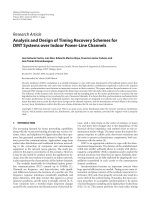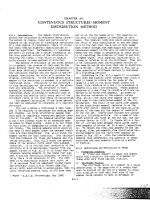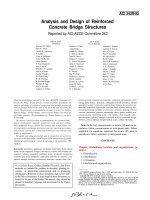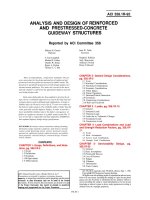Fatigue analysis and design of steel concrete steel sandwich composite structures
Bạn đang xem bản rút gọn của tài liệu. Xem và tải ngay bản đầy đủ của tài liệu tại đây (8.56 MB, 305 trang )
FATIGUE ANALYSIS AND DESIGN OF STEEL-
CONCRETE-STEEL SANDWICH COMPOSITE
STRUCTURES
DAI XUEXIN
NATIONAL UNIVERSITY OF SINGAPORE
2009
FATIGUE ANALYSIS AND DESIGN OF STEEL-
CONCRETE-STEEL SANDWICH COMPOSITE
STRUCTURES
DAI XUEXIN
(B.Eng., Tianjin Urban Construction Institute; M.Eng., Tianjin University)
A THESIS SUBMITTED
FOR THE DEGREE OF DOCTOR OF PHILOSOPHY
DEPARTMENT OF CIVIL ENGINEERING
NATIONAL UNIVERSITY OF SINGAPORE
2009
Acknowledgements
ACKNOWLEDGEMENTS
I wish to express my deepest gratitude to my supervisor, Prof. Liew Jat Yuen, Richard for
his full support, invaluable guidance and constructive advices on research, paper writing
and presentation skills. I would also like to thank Prof. Zhang Min-Hong for her kindly
help and informative suggestions.
My sincere appreciation is dedicated to Dr. Chia Kok Seng in concrete development, Mr.
Wang Zhen in ship theory and Dr. Kazi Md. Abu Sohel for many times of valuable
discussions and supports.
The kindly assistance from all the staff members in NUS Structural and Concrete
Laboratory is deeply appreciated. Special thanks goes to Ms. Tan Annie, Mr. Ang Beng
Oon, Mr Koh Yian Kheng, Mr Ishak Bin A Rahman, Mr. Choo Peng Kin and Mr Ow
Weng Moon for their continuous support during testing. Sincere thanks are also given to
colleagues in my office during the year 2004 to 2008 for the happy moments we have
shared.
I also like to thank my parents for their full supports in my course of study.
Finally, the research scholarship provided by National University of Singapore is greatly
acknowledged.
i
Table of Contents
ii
TABLE OF CONTENTS
ACKNOWLEDGEMENTS………………………………………… i
TABLE OF CONTENTS …………………….………………………… ii
SUMMARY ……………………………….………………………… vi
LIST OF TABLES
………………………….…………………… viii
LIST OF FIGURES …………………….…………………… xii
LIST OF SYMBOLS………………….…………… xix
LIST OF ACRONYMS ………………….……….… xxii
CHAPTER 1 INTRODUCTION…………………….………….…….….… …………1
1.1 Literature Review………………….…………….………….……….… …………1
1.1.1 Sandwich Construction…….……….….……….………… … …….……1
1.1.2 Steel-Concrete-Steel (SCS) Sandwich Construction…… … … ….……3
1.1.3 Fatigue on Steel-Concrete Composite Structures.… …… … ….………8
1.2 Motivation of Research…….…………….………….……….… …………11
1.3 Research Scope and Objectives………………………….……… ………….…15
1.4 Overview of Contents ……………….…………….………….…….…….…….16
CHAPTER 2 FEASIBILITY STUDY ON DOUBLE HULL STRUCTURE.…… 24
2.1 Introduction …………………………… …….…………………… …… … 24
2.1.1 Sandwich Effect of Structural Component….…….……
… … 24
2.1.2 Sandwich Effect on Ship Structure………………… …… ……… 27
2.2 Global Comparison………………………….…………………
… ………… 32
2.2.1 Global Comparison under Sagging Moment Load Condition … … … 33
2.2.2 Global Comparison under Hogging Moment Load Condition …
….… 36
Table of Contents
2.3 Local Comparison with Stiffened Steel Plate ……………….… ….…… 38
2.4 Weight Comparison……………….………………………… ………… … 42
2.5 Summary …………………………….………………………….…………… 43
CHAPTER 3 DEVELOPMENT OF LIGHTWEIGHT CONCRETE….… 66
3.1 Introduction …………….……………….…….…………….… …….…… 66
3.2 Lightweight Aggregate Concrete (LWAC) .……………….…………… ………68
3.2.1 Experimental Details.………………….…….……….… … …………70
3.2.2 Static Properties.……………………… …………….…… … ………74
3.2.3 Toughness.……………………….…………….…….…… ……………75
3.2.4 Comparison of S–N Curves…….………….………….………….………76
3.2.5 Concluding Remarks…………….…………….………… ……………78
3.3 LWAC with Air Entraining Agent (AEA).………….…………….……….… …79
3.3.1 Fibers…………….…………….………….….……….….………………79
3.3.2 Static Properties…………….…………….………….….…… …… …80
3.3.3 Toughness…………….…………….………….….………… …….……81
3.3.4 Fatigue Performance…………….…………….………… …… ………82
3.3.5 Cost Analysis…………….…………….………….….……….…….……83
3.3.6 Concluding Remarks…………….…………….………………… … …83
3.4 LWAC with Expanded Glass Granules.……………………… ……………… 84
3.4.1 Density Check of Trial Mix………………….……… ……….…….… 84
3.4.2 Fiber-reinforced LWAC (FL) Development……………….… … …….87
3.4.3 Concluding Remarks…………….…………….……………… … …87
3.5 Summary…………….…………….………….….……….… ………… …… 88
CHAPTER 4 STATIC BEHAVIOR OF STEEL-CONCRETE-STEEL
SANDWICH COMPOSITES…………… …….… … ………126
4.1 Introduction …………………………….…………… …………… …………126
4.2 Analytical Studies………………………………… …………… ……………131
iii
Table of Contents
4.3 Test Specimens …………………………….…………….……….…………….134
4.4 Test Setup and Instrumentations……………….………… … ……… ……. 135
4.5 Testing Procedures …………………………….…………… ……….……… 137
4.6 Results and Discussions……………………….……………… ….… …… 138
4.6.1 Load Deflection Behaviour……………… …….……….….… …… 138
4.6.2 Load Slip Behaviour……………………….…………… ……….… 140
4.6.3 Strain Readings……………………….……………….…….… … 141
4.7 Summary ……………………………….……………………………….…… 142
CHAPTER 5 FATIGUE PERFORMANCE OF STEEL-CONCRETE-STEEL
SANDWICH COMPOSITES………………………………… ……158
5.1 Research Significance …………………………….………….……… … ……158
5.2 Test Program …………………………….…………………….………… ……159
5.3 Results and Discussions ………… ……………….…………………… ……160
5.3.1 Three-parameter Fatigue Load Relationship……….………… … … 160
5.3.2 Hysteretic Responses……………………………….… ……………….161
5.3.3 Permanent Deformation……………………………… …… ……… 163
5.3.4 Stiffness Degradation………………………………….…… …… ….165
5.3.5 Energy Dissipation……………………………… ………… … ….168
5.4 Design Implications……………………….……… …………… …… …… 171
5.4.1 Three-parameter Fatigue Design Equation………………… …… … .172
5.5 Summary …………………………….………………………………………….179
CHAPTER 6 STRENGTH IMPROVEMENT OF STEEL-CONCRETE-STEEL
SANDWICH BY TEXTURED INTERFACE…….… … ……… 194
6.1 Introduction …………………………….… …………………… …… …….194
6.2 Expamet …………………………….……………………… ……… ……….195
6.3 Test Program …………………………….… ……………………… ….…….196
iv
Table of Contents
6.3.1 Push-out Tests……………………… …….….………………….…….196
6.3.2 Beam Tests………………………… …… …………….……….…….198
6.4 Results and Discussions …………………… ……….………………… …….200
6.4.1 Push-out Tests…………………………… … …….….……… …….201
6.4.2 Beam Static Tests………………………… …………… …… …….203
6.4.3 Beam Fatigue Tests…………………………… ………….….……….208
6.5 Summary …………………………….………… ………………… … …….213
CHAPTER 7 CONCLUSIONS AND FUTURE WORK…………………… …….240
7.1 Conclusions …………………………….…………… …………… …………240
7.2 Future Work ………………………………… …………… ……………245
REFERENCES ……………………………….……………………………… 249
APPENDIX I: CALCULATION FOR SANDWICH STRUCTURAL
COMPONENT COMPARISON …… …… ….…………… ….…….261
APPENDIX II.1: CALCULATION PROCEDURE FOR GLOBAL
COMPARISON UNDER SAGGING MOMENT LOAD CONDITION 263
APPENDIX II.2: CALCULATION PROCEDURE FOR GLOBAL
COMPARISON UNDER HOGGING MOMENT LOAD CONDITION 267
APPENDIX III: MIX PROPORTIONING DESIGN OF FL TRIALS … … 272
PUBLICATION LIST……………………… ……………….…………… 281
v
Summary
vi
SUMMARY
Lightweight and relatively high stiffness are main characteristics that make sandwich
composite to be feasible in marine and offshore applications. It is thus proposed that by
filling steel face plates with lightweight concrete may create a promising sandwich
structural system. This steel-concrete-steel (SCS) sandwich possessing lightweight by
means of thinner core depth and lightweight infill concrete will lead to lightweight
sandwich composite system. Comparison studies were conducted to determine profile of
SCS sandwich panel employed in marine and offshore applications. Based on global
comparison of a product/chemical carrier, thickness of steel face plates in SCS sandwich
panel can be set as half of original steel plate thickness.
A type of fiber-reinforced lightweight aggregate concrete (LWAC) with expanded glass
granules is developed for the proposed lightweight sandwich composite system. A
standard casting procedure is also established for quality control of fresh concrete. To
minimize brittleness and enhance ductility of the concrete, steel fibers were added in.
Static test results show that tensile, flexural strength and energy absorption capacity are
enhanced by addition of fibers. Fatigue performance of steel fiber reinforced LWAC is
also improved. From comparison of concrete with three types of fibers, hook-ended steel
fibers show superior properties and is recommended. One percent volume fraction dosage
is recommended if cost is taken into account.
A fatigue test program with SCS sandwich beams aimed to investigate the effect of two
loading parameters is conducted. Test results demonstrate that both maximum applied
load and load range affect equally and independently on structural behavior of SCS
sandwich member. Fatigue life reduces when load range or maximum applied load
increases. A three-parameter fatigue design equation is proposed based on test results.
The three-parameter fatigue design equation shows that maximum applied stress yields
significant effect on fatigue performance when the difference between the maximum
applied stress and the stress range is considerable. In this case, only considering stress
range without taking into account maximum applied stress will lead to un-conservative
Summary
prediction of fatigue life. The three-parameter fatigue design equation can also be
degenerated to similar design equations in existing codes by assuming minimum applied
stress to be zero. From the S-N curves comparison, it is demonstrated the hooked
connector perform as well as conventional headed shear studs.
A type of textured interface, Expamet, is proposed to be used for strength improvement
of SCS sandwich composites. Push-out tests show that bonding strength of textured
interface increased significantly compared to that without it. Mechanical anchorage of
this type of textured interface inhibits formation of cracks in infill concrete core and
enhances bonding at steel-concrete interface, thus increasing static load carrying capacity
of SCS sandwich composites. Expamet meshes can serve as a type of ‘linear or surface
connector’ which is complementary with ‘point connector’ such as shear stud. Expamet
also improves fatigue performance of SCS composite structures with no addition on
structural weight. This is a superior choice with an aim to increase fatigue life for weight-
sensitive structures.
vi
i
List of Tables
viii
LIST OF TABLES
Table 2.1 Comparison of flexural rigidity and response stress in case study (1) 45
Table 2.2 Comparison of flexural rigidity and response stress using ductile material in
case study (1) 45
Table 2.3 Moments on ship and stresses at deck and bottom in case study (2) 45
Table 2.4 Comparison of case study (2) 45
Table 2.5 Steel grades for offshore applications 46
Table 2.6 Comparison table for HISTAR grades 46
Table 2.7 Tensile properties of steel in ASTM A 913 standard 46
Table 2.8 Principal dimensions of 16K DWT class product/chemical carrier 46
Table 2.9 Dimensions and section properties of side shell longitudinal stiffeners 47
Table 2.10 Section properties of simplified half ACS 47
Table 2.11 Properties comparison between steel and concrete 47
Table 2.12 Moment load of 16K DWT class product/chemical carrier 48
Table 2.13 Minimum thickness of core material under sagging moment load condition
and 150),3.37,,( hMS
tfdd
S
48
Table 2.14 Minimum thickness of core material under hogging moment load condition
and
150),3.37,,(
tfbb
hMSS
48
Table2.15 Integrating parts on cross section of SCS model 48
Table 2.16 Required thicknesses for SCS panel with equivalent flexural rigidity D to
stiffened steel plate 49
Table 2.17 Proposed plate girder systems for alternative SCS profiles 49
Table 2.18 Weight comparison of ACS constructed with SCS infilled with different
lightweight concrete 50
Table 3.1 Properties of Liapor lightweight coarse aggregate (LWAC) 90
Table 3.2 Properties of steel fibers 91
List of Tables
Table 3.3 Mix proportion of lightweight aggregate concrete (LWAC) 91
Table 3.4 Typical loading frequencies of fatigue tests from literature 92
Table 3.5 Static properties of LWAC 93
Table 3.6 Comparison of toughness related parameters between fiber-reinforced
LWAC 93
Table 3.7 Fatigue test results of plain LWAC…… 94
Table 3.8 Fatigue test results of fiber reinforced LWAC 95
Table 3.9 Properties of steel and PVA fibers 96
Table 3.10 Mix proportion of LWAC with AEA 96
Table 3.11 Static properties of LWAC with AEA 96
Table 3.12 Comparison of static flexural strength and toughness of LWAC with AEA 97
Table 3.13 Comparison of fatigue performance of LWAC with AEA 97
Table 3.14 Comparison of cost for LWAC with AEA 98
Table 3.15 Comparison of Performance/ Cost index of LW
AC with AEA………… 98
Table 3.16 Properties of expanded glass granules 98
Table 3.17 Density and strength of concrete mix FL1 (target density 1250kg/m
3
) 98
Table 3.18 Trials to investigate FL density 99
Table 3.19 Casting trials to check FL density variation 100
Table 3.20 Density check for FL3 by drummixer 101
Table 3.21 Density check for FL4 by drummixer 101
Table 3.22 Concrete mix trial by drum mixer 102
Table 3.23 FL trials (see Appendix III for detailed mix proportioning design) 103
Table 3.24 Mechanical properties of FL and PL 104
Table 3.25 Comparison of the developed lightweight concrete 104
Table 5.1 Normal fatigue design practice in civil engineering 181
Table 5.2 Worked example 181
ix
List of Tables
Table 6.1 Mesh dimensions (mm) 215
Table 6.2 Push-out test results for hooked connectors and Expamet interface 216
Table 6.3 Results of beam static tests 217
Table 6.4 Results of beam fatigue tests 218
Table 6.5 Worked example 219
Table II.1.1 Location of NA under sagging moment load condition 265
Table II.1.2 Moment of inertia under sagging moment load condition 267
Table II.2.1 Location of NA under hogging moment load condition 269
Table II.2.2 Moment of inertia under hogging moment load condition 271
Table III.1 Mix design of FL1 273
Table III.2 Mix design of FL2 273
Table III.3 Mix design of FL3 274
Table III.4 Mix design of FL4 274
Table III.5 Mix design of FL5 275
Table III.6 Mix design of FL6 275
Table III.7 Mix design of FL7 276
Table III.8 Mix design of FL8 276
Table III.9 Mix design of FL9 277
Table III.10 Mix design of FL10 277
Table III.11 Mix design of FL11 278
Table III.12 Mix design of FL12 278
Table III.13 Mix design of FL13 279
Table III.14 Mix design of FL14 279
Table III.15 Mix design of FL15 (The finalized design of FL) 280
Table III.16 Mix design of plain lightweight aggregate concrete (PL) corresponding to
FL 280
x
List of Tables
xi
Table III.17 Standard casting procedure for FL 281
List of Figures
LIST OF FIGURES
Figure 1.1 Section through a bird's wing and Laser Welded All Metal Sandwich Panel .19
Figure 1.2 Sandwich composite construction of the Apollo Capsule ………… 19
Figure 1.3 Double-Skin Composite (DSC) construction………… 20
Figure 1.4 Stresses diagram in Double-Skin Composite (DSC) elements 20
Figure 1.5 Truss model for Bi-Steel element 21
Figure 1.6 Various attempts to construct ship by advanced composites ……………… 22
Figure 1.7 Ship double-hull construction …………….………………… 22
Figure 1.8 Replacement of ACS built with single stiffened steel plates with ACS
constructed with SCS panels … 23
Figure 2.1 Four structural types in case study (1) 51
Figure 2.2 Stress concentration factors for structural type IV in case study (1) (Juvinall
and Marshek, 2000) 51
Figure 2.3 Still water buoyancy, wave buoyancy and mass distribution curves (Muckle
and Taylor, 1987)……………………………………………………………………… 52
Figure 2.4 Original simplified ACS of a vessel built with single steel plate (Muckle and
Taylor, 1987) 52
Figure 2.5 Comparative simplified ACS constructed with 8mm/50mm/8mm SCS pane.53
Figure 2.6 Detailed dimensions of original half ACS of a 16K DWT class
product/chemical carrier (unit: mm) 54
Figure 2.7 Detailed dimensions of simplified half ACS of a 16K DWT class
product/chemical carrier (unit: mm) 55
Figure 2.8 Location of neutral axis and section properties of simplified half ACS of a
16K DWT class product/chemical carrier 56
Figure 2.9 Coordinate transformation to determine location of neutral axis of ACS
constructed with SCS panel 57
Figure 2.10 Relationship of
and
f
he,
t
under sagging moment load condition 58
Figure 2.11 Relationship of
and
ff
hED ,/
t
under sagging moment load condition 58
xi
i
List of Figures
Figure 2.12 Deck and bottom stresses under 1112 MNm sagging moment load
condition… 59
Figure 2.13 Relationship of deck stress S
d
vs.
t
for 6.5
f
hmm
or steel face
plate 59
8.0mm
Figure 2.14 Relationship of and
f
he,
t
under hogging moment load condition 60
Figure 2.15 Relationship of
and
ff
hED ,/
t
under hogging moment load
condition 60
Figure 2.16 Deck and bottom stresses under 1284 MNm hogging moment load
condition 61
Figure 2.17 Relationship of deck stress S
d
vs.
t
for 6.5
f
hmm
or steel face
plate 61
8.0mm
Figure 2.18 Relationship of bottom stress vs.
t
for
6.5
f
hmm
or steel face
plate 62
8.0mm
Figure 2.19 Det
ailed dimensions and section properties of stiffened steel plate
63
Figure 2.20 SCS model for local comparison and its equivalent stress diagram across
section 63
Figure 2.21 Relationship of and aD
n
,
x
for local comparison 64
Figure 2.22 Typical relationship curves for and
n
D
x
64
Figure 2.23 Proposed 10mm thick plate girder systems (unit: mm) 65
Figure 2.24 Proposed 6mm thick plate girder systems (unit: mm) 65
Figure 3.1 Bridging Mechanism of fibers in concrete 105
Figure 3.2 Comparison between S–N curves for plain and SFRC (0.5% and 1.0% fiber
content) under flexural loading (Lee and Barr, 2004) 105
Figure 3.3 Expanded clay type of lightweight
coarse aggregate (LWCA) 106
Figure 3.4 Failure modes of concrete cube specimen under compression 106
Figure 3.5 Steel fibers (30mm hook-ended and 13mm straight)………… 106
Figure 3.6 Schematic view of static flexural test 107
x
iii
List of Figures
Figure 3.7 Test apparatus for static flexural test of concrete prism in laboratory 107
Figure 3.8 Test apparatus for splitting tensile strength test of concrete cylinder
108
Figure 3.9 Fatigue load history and symbols 108
Figure 3.10 Failure modes of plain LWAC and fiber reinforced LWAC under
compression………………………………… 109
Figure 3.11 Comparison of static flexural strength between plain LWAC and fiber
reinforced LWAC 109
Figure 3.12 Comparison of splitting tensile strength between plain LWAC and fiber
reinforced LWAC 110
Figure 3.13 Failure mode of splitting tensile strength test for plain
LWAC 110
Figure 3.14 Failure mode of splitting tensile strength test for fiber reinforced
LWAC 111
Figure 3.15 Ductile failure of fiber-reinforced LWAC cylinder 111
Figure 3.16 Important characteristics of load-deflection curve for FRC (ASTM C1018-
97, 1997) 112
Figure 3.17 Comparison of toughness related parameters between fiber reinforced
LWAC 112
Figure 3.18 Regression models of fatigue test results for plain LWAC and fiber
reinforced LWAC 113
Figure 3.19 Configuration of steel fibers (30mm hook-ended and 13mm
straight) 113
Figure 3.20 PVA fibers (30mm straight) 113
Figure 3.21 Arrangement to obtain net deflection by using two transducers mounted on
jig secured to specimen directly above supports (ASTM C1609/C1609M-05, 2005) 114
Figure 3.22 Measurement of net deflection by rectangular jig 114
Figure 3.23 Load-deflection curve for batch PVAF1-1 (PVAF1-1-4) 115
Figure 3.24 Load-deflection curve for batch PVAF1-2 (PVAF1-2-6) 115
Figure 3.25 Load-deflection curve for batch SF1-1 (SF1-1-6) 116
xi
v
List of Figures
Figure 3.26 Load -deflection curve for batch SF1-2 (SF1-2-6) 116
Figure 3.27 Load -deflection curve for batch SF2-1 (SF2-1-5) 117
Figure 3.28 Comparison of load-deflection curves of LWAC with AEA up to 2 mm 117
Figure 3.29 Comparison of load-deflection curves of LWAC with AEA up to 8 mm 118
Figure 3.30 Comparison of static flexural strength for LWAC with AEA 118
Figure 3.31 Lightweight fine aggregate - expanded glass granules 119
Figure 3.32 Lightweight fine (size: 2-4mm) and coarse aggregate (size: 2-10mm) 119
Figure 3.33 Hobart mixer for trial mix 120
Figure 3.34 Container for density check: containing capacity: 804 ml, self-weight: 20.4
g 120
Figure 3.35 Hobart mixer, batch weight of concrete volume about 2 liter 121
Figure 3.36 Drummixer used for verification of lightweight concrete density 121
Figure 3.37 Cube specimen of FL3 after demould 122
Figure 3.38 Cube specimens of FL3 and FL14 after compression failure 122
Figure 3.39 Mould and wire mesh for bone tensile specimen 122
Figure 3.40 Direct tensile test of bone specimen 123
Figure 3.41 Stress strain curves of FL and PL in compression 123
Figure 3.42 Stress strain curves of FL and PL in tension…………………… 124
Figure 3.43 Static flexural strengths of FL and PL concrete 125
Figure 4.1 Existing connector forms in SCS sandwich construction 143
Figure 4.2 Proposed confinement methods for confined sandwich panel 143
Figure 4.3 Stud welding process (Weman, 2003) 143
Figure 4.4 Schematic view of 3-dimentional ‘root connector’ (unit: mm) 144
Figure 4.5 Assembly of ‘root connector’ (unit: mm)…………… 144
Figure 4.6 Idea of wave connector 145
Figure 4.7 Assembly of ‘wave connector’ (unit: mm) 145
xv
List of Figures
Figure 4.8 Expansion bolt 145
Figure 4.9 Mechanical joining-up connector (unit: mm) 146
Figure 4.10 Assembly of mechanical joining-up connector 146
Figure 4.11 Profile of 10mm-diameter hooked connector (unit: mm) 146
Figure 4.12 Diagram of SCS cross section 147
Figure 4.13 Material properties of steel connectors and steel face plates 148
Figure 4.14 Schematic view of beam test set-up and dimensions (unit: mm) 149
Figure 4.15 Beam test set-up and instrumentations in laboratory conditions 150
Figure 4.16 Measurements of relative slip between steel and concrete core 150
Figure 4.17 Strain gauge instrumentations on steel plates and connectors 151
Figure 4.18 Shear crack development in beam PP 151
Figure 4.19 Load deflection behavior of SCS beams 152
Figure 4.20 Load relative slip behavior of SCS beams 154
Figure 4.21 Failure modes of SCS beams 155
Figure 4.22 Connector failure modes 155
Figure 4.23 Strains on steel face plates 156
Figure 4.24 Variation of connector strain under static load 157
Figure 5.1 Fatigue Loading parameters 182
Figure 5.2 Variation of fatigue loading parameters 182
Figure 5.3 Data distribution of fatigue life 183
Figure 5.4 Regression relationship of fatigue life and maximum applied load ratio 183
Figure 5.5 Hysteretic response of load vs. deflection for SCS beams under cyclic
load …… 184
Figure 5.6 Hysteretic response of load vs. relative slip for SCS beam under cyclic
load …… 185
Figure 5.7 Variation of connector strain under cyclic loads in beam P54 186
xvi
List of Figures
Figure 5.8 Variation of permanent deformation with number of load cycles 187
Figure 5.9 Illustration of permanent deformation, stiffness and energy absorption 188
Figure 5.10 Variation of net central beam deflection with number of load cycles 189
Figure 5.11 Variation of relative slip with number of load cycles 189
Figure 5.12 Stiffness degradation 190
Figure 5.13 Variation of unit work in loading and unloading process of a static loop 191
Figure 5.14 Variation of energy dissipation with increase of number of load cycles 192
Figure 5.15 Graphical expression of fatigue design Equation (5.17) 192
Figure 5.16 Tearing of bottom steel plate in specimen P54 193
Figure 5.17 Comparison S-N curves with existing codes 193
Figure 6.1 Selected applications of Expamet 220
Figure 6.2 Textured interfaces 221
Figure 6.3 Push–out test set-up 222
Figure 6.4 Profile of hooked connector (unit: mm) 222
Figure 6.5 Steel face plates with 10mm-diameter hooked connectors (unit: mm) 223
Figure 6.6 Steel face plates with 8mm-diameter hooked connectors (unit: mm) 223
Figure 6.7 SCS sandwich beams before casting 223
Figure 6.8 Failure modes of hooked connectors 224
Figure 6.9 Load slip behavior of hooked connector 225
Figure 6.10 Shear crack in specimen with Expamet interface 225
Figure 6.11 Load slip behavior of specimens with textured interface 226
Figure 6.12 Peeling off of concrete core 227
Figure 6.13 Fractured surface of connector in specimens with textured interface 227
Figure 6.14 Crack development of beam NEP 228
Figure 6.15 Load deflection behaviors at early stage 229
xvi
i
List of Figures
Figure 6.16 Load deflection behavior of whole range 231
Figure 6.17 Initiation of shear crack in beam EP 232
Figure 6.18 Inhibition of relative slip by Expamet interface in beam EP 232
Figure 6.19 Load bottom slip behavior at early stage (δ
L-b
or δ
R-b
which initiates
earlier) 234
Figure 6.20 Load relative slip behavior in the whole loading 235
Figure 6.21 Strains on steel face plates 236
Figure 6.22 Variation of connector strain under static load 237
Figure 6.23 Data distribution of fatigue life for beams with Expamet interface 238
Figure 6.24 Regression relationship of fatigue life and maximum applied load ratio for
beam with Expamet interface 238
Figure 6.25 Comparison of S-N curves with existing codes 239
Figure 7.1 Oil drilling platforms in arctic region 247
Figure II.1.1 Half ACS under sagging moment load condition 264
Figure II.2.1 Half ACS under hogging moment load condition 268
x
viii
List of Symbols
xix
LIST OF SYMBOLS
A Area of cross section of interface
b Width of sandwich component
B Width of the steel plate or sandwich beam
B
t
Width at which τ is calculated
C, k, g, h Constants in equation derivation or fatigue design equation
C
b
Block coefficient
d Diameter of the connector or hole on a sandwich component
D Flexural rigidity of sandwich panel
E Elastic modulus of materials
f
E Elastic modulus of face plate in sandwich panel
c
E Elastic modulus of core material in sandwich panel
e Location of neutral axis measured from baseline
f
c
, f
t
Stress at the compression and tension plate respectively
f
r
Modulus of rupture of fiber reinforced concrete specimen
f
y
, f
u
Yield and ultimate strength of steel
f
max
Maximum fatigue stress to fiber reinforced concrete specimen
F Applied load in push-out tests
F
u
Peak load of push-out test
h
c
Thickness of core material in sandwich panel
f
h Thickness of face plate in sandwich panel
K
t
Stress concentration factor
K
tg
Gross concentration factor
K
tn
Net concentration factor
I
n
Toughness related parameters
l Length of sandwich component or sandwich beam
N
f
Fatigue life, i.e. the number of cycles to failure
m , K Constants determined by regression analysis of fatigue test data
M Moment capacity of cross section
n Number of connectors
List of Symbols
n
i
The applied number of cycles of the corresponding stress magnitude Δσ
i
N
i
The number of cycles to failure of the corresponding stress magnitude Δσ
i
N
R
The number of stress-range cycles
P Applied load
P
u
Static ultimate load
P
max
Maximum applied load
P
min
Minimum applied load
P
mean
Mean value of the applied loads, 2/
max
PPP
mean
ΔP Load range,
minmax
PPP
Rk
P The shear resistance of connector
P
RE
Shear resistance of hooked connector in combination with Expamet interface
Q Shear force
R
x
Radius of curvature
s
x
, s
y
Connector spacing in longitudinal and lateral directions respectively
s
ux
The required connector spacing in longitudinal direction for full composite action
S First moment of area of the part above where τ is calculated
S The applied stress range
S
b
, S
d
Stresses at ship deck and bottom
S
r
, ∆S Stress range
S
a
Stress amplitude
S
max
Maximum applied stress
S
min
Minimum applied stress
s
max
Maximum stress level
s
min
Minimum stress level
S
MOR
Static flexural strength (modulus of rapture) of concrete prism specimen
t
c
, t
t
The thickness of compression and tension steel face plates respectively
T
A
Anticipated lifetime of a structural component
T
D
Design lifetime of a structural component
u Deflection
z Vertical distance measured from neutral axis of a cross section; The position of
the neutral axis, measured from the underneath of the compression steel plate
E
The ratio of elastic modulus between steel and concrete, i.e.
cs
EE /
xx
List of Symbols
t
Thickness ratio between core material and face plate in sandwich panel, i.e. h
c
/h
f
d
Density ratio between core material and face plate in sandwich panel
α Degree of composite
δ Relative slip
Δτ Shear stress range
Δσ
i
(1 ≤ i ≤ k) Different stress magnitudes in a loading history
γ
Mf
Material partial factor for fatigue
γ
Ff
Load partial factor for fatigue
τ
max
Maximum applied shear stress
τ
min
Minimum applied shear stress
τ
u
Static ultimate strength of the connector
τ
b
Bond strength of interface
Δτ
R
The fatigue shear strength related to the cross-sectional area of the shank of the
stud, using the nominal diameter d of the shank
Δτ
c
The reference value at N
c
= 2 ×10
6
cycles with Δτ
c
equal to 90 N/mm
2
σ
max
Maximum stress
σ
nom
Nominal stress
xxi
List of Acronyms
xxii
LIST OF ACRONYMS
ACS Amidships cross section
DWT Dead weight tonnage
FRC Fiber-reinforced concrete
LWC Lightweight concrete
LWAC Lightweight aggregate concrete
LWCA Lightweight coarse aggregates
SFRC Steel fiber reinforced concrete
SCS Steel-Concrete-Steel
Chapter 1 Introduction
CHAPTER 1 INTRODUCTION
1.1 Literature Review
1.1.1 Sandwich Construction
Sandwich construction is relatively new, even though the origin of sandwich construction
can be traced back to Fairbairn (1849). Sandwich composite structures possess inherent
superiorities compared to other simple plate-like structures. Figure 1.1 shows a cross
section through a bird’s wing. Two face plates are separated apart and kept away about a
certain distance by internal ribs, thus inducing significantly-increased flexural rigidity
and strength to well resist static and dynamic loads such as strong wind. Inspired by
nature, man creates sandwich composite structures as shown in Figure 1.1. This type of
sandwich composite consists of two steel face plates separated and supported by folded
steel web plates welded to them. This provides a composite structure that is much stiffer
than the sum of stiffness of individual components. The infill foam can prevent buckling
of face plates and increase flexural rigidity of sandwich composite as well.
Sandwich composite structures thus can be simply defined as a three layer panel,
consisting of two thin outer skins of high strength material separated by a low density and
low weight core material. The basic concept is that the core material separates the face
- 1 -









